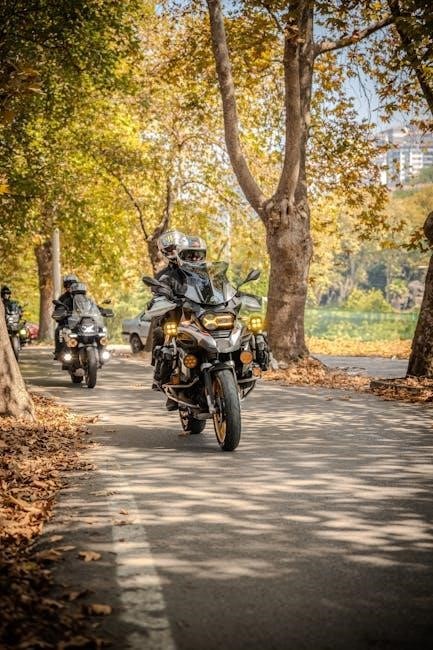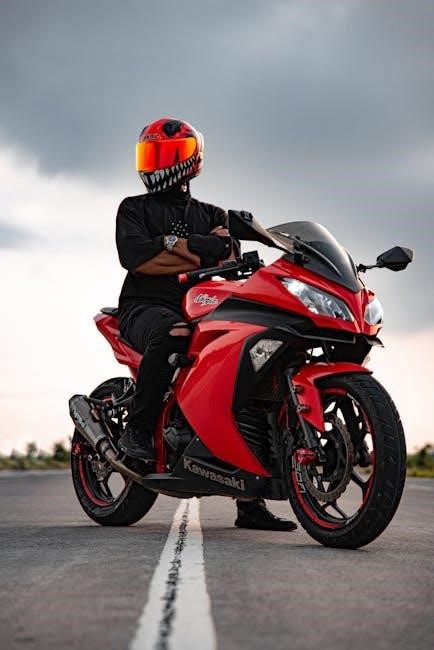Choosing the right bike size is essential for comfort, performance, and safety. Trek’s size guide helps riders find the perfect fit across various bike models and styles. Whether you’re exploring road, mountain, or hybrid bikes, understanding your size ensures an optimal riding experience. This guide will walk you through the process of determining your ideal Trek bike size, considering factors like height, inseam, and riding style.
Understanding the Importance of Proper Bike Fit
Proper bike fit is crucial for comfort, efficiency, and safety while riding. A well-fitted bike ensures optimal performance, reducing the risk of discomfort or injury. Factors like standover height, saddle height, and handlebar reach play a significant role in achieving the right fit. Incorrect sizing can lead to poor posture, strain, or difficulty controlling the bike. Trek’s size guide helps riders determine their ideal frame size based on height and inseam, ensuring a comfortable and efficient riding experience. Whether commuting, racing, or trail riding, a proper fit enhances overall enjoyment and performance. Investing time in getting the right size is essential for maximizing your cycling experience.
Overview of Trek’s Bike Size Chart
Trek’s bike size chart is a comprehensive tool designed to help riders select the ideal frame size based on their height and inseam. The chart categorizes sizes into numerical or alphabetical ranges, ensuring a precise fit for various bike models. It accommodates men, women, and children, with specific charts for different bike types, such as road, mountain, and hybrid bikes. By measuring standover height and inseam, riders can align their dimensions with Trek’s guidelines to find the perfect match. The chart also considers riding style and comfort, offering a range of sizes to suit diverse preferences. Accurate measurements are crucial, as they directly impact the riding experience. Trek’s size chart is a valuable resource for anyone looking to purchase a bike that meets their specific needs.

Understanding Trek Bike Frame Sizes
Bike frame sizes are crucial for optimal riding comfort and performance. Trek offers a range of frame sizes tailored to different rider heights and preferences, ensuring proper fit and handling. Standover height and inseam measurements are key factors in determining the right size, while the frame size directly impacts riding posture and efficiency. Trek’s sizing system is designed to cater to various riding styles and body types, providing a personalized fit for every cyclist.
What is Standover Height and Why is it Important?
Standover height is the measurement from the ground to the top of the bike frame, directly above the bottom bracket. It plays a crucial role in ensuring a safe and comfortable riding experience. Proper standover height allows riders to dismount quickly and maintain control, especially on uneven terrain. A general rule of thumb is to have 1-2 inches of clearance for road bikes and 2-4 inches for mountain bikes. This clearance ensures comfort and prevents discomfort or injury. Measuring standover height accurately is essential for selecting the correct frame size, as it directly impacts how well the bike fits the rider. Proper fit enhances performance, efficiency, and overall enjoyment of cycling.
How to Measure Your Inseam for Bike Sizing
To measure your inseam for bike sizing, stand barefoot with your back against a wall. Place a sturdy book or similar object between your legs, simulating the bike saddle. The book should be snug but not uncomfortable. Measure the distance from the floor to the top of the book using a tape measure or ruler. This measurement represents your inseam. For accuracy, repeat the process a few times and take the average. Your inseam is crucial for determining the correct standover height and frame size, ensuring a safe and comfortable fit. Proper inseam measurement helps in selecting the right bike size for optimal performance and riding experience.
Trek’s Bike Size Chart Explained
Trek’s size chart provides frame sizes, inseam ranges, and corresponding rider heights. It helps riders select the ideal bike size for comfort, efficiency, and performance.
Men’s Bike Size Chart
Trek’s men’s bike size chart categorizes frame sizes based on rider height and inseam. Typical sizes range from 13″ to 23″, with corresponding height ranges. For example, a 16″ frame suits riders 5’4″-5’7″, while a 20″ frame fits those 5’10”-6’1″. The chart ensures optimal fit by aligning standover height and saddle adjustment. It’s crucial to match your inseam and height to the chart for comfort and performance. Always consult the chart for precise sizing, as variations exist across bike types. Proper fit enhances riding efficiency and reduces fatigue, making it essential for all cyclists.
Women’s Bike Size Chart
Trek’s women’s bike size chart offers a range of frame sizes designed to fit various rider heights and inseams. Typically, sizes range from 13″ to 19″, with corresponding height recommendations. For example, a 13″ frame suits riders around 4’11”-5’2″, while a 17″ frame accommodates those 5’6″-5’8″. The chart ensures proper fit by aligning standover height and saddle adjustments. It’s essential to match your height and inseam to the chart for optimal comfort and performance. Always consult the chart for accurate sizing, as specifications may vary slightly across different bike models. Proper fit enhances riding efficiency and reduces fatigue, making it crucial for all cyclists to use the chart effectively for a better riding experience.
Children’s Bike Size Chart
Trek’s children’s bike size chart is designed to ensure young riders find the perfect fit. Sizes typically range from 12″ to 24″ wheel bikes, catering to ages 2-12 years. The chart aligns wheel size with the child’s height and inseam, ensuring proper leg clearance and control. For example, a 12″ bike suits 2-4 years, while a 20″ bike fits 7-9 years. Standover height is crucial for safety, allowing the child to dismount easily. The chart also considers growth, offering adjustable features. Proper sizing enhances balance, safety, and riding comfort. Parents should consult the chart and test bikes to ensure the best fit for their child, promoting a lifelong love for cycling.

How to Choose the Right Trek Bike Size
Start by measuring your standover height and inseam. Consult Trek’s size chart to match your measurements with the appropriate frame size. Consider your riding style, bike type, and personal comfort. Test rides are recommended to ensure the best fit and optimal performance. Proper sizing enhances control, efficiency, and overall cycling experience. Use Trek’s guidelines to find your ideal bike size for a perfect ride every time.
Step-by-Step Guide to Determining Your Size
To find your ideal Trek bike size, start by measuring your inseam accurately. Stand barefoot with your feet 6 inches apart and measure from the floor to the top of your inner thigh. Use this measurement to find your standover height by subtracting 2-4 inches. Consult Trek’s bike size chart, matching your inseam to the corresponding frame size. Consider your riding style and bike type—road bikes, mountain bikes, and hybrids have different size requirements. Ensure proper standover clearance for safety and comfort. Adjust handlebar reach and saddle height for optimal fit. Test rides are crucial to confirm the size and ensure a comfortable, efficient ride. Avoid common mistakes like misjudging standover height or neglecting adjustments. Professional fitting services can provide personalized recommendations, especially if you’re between sizes or unsure about specific models. By following these steps, you’ll be well-equipped to choose a Trek bike that suits your needs perfectly, enhancing your overall cycling experience.
Understanding Bike Types and Their Size Requirements
。,。,,。,,。,Trek,。,Trek,。,。

Factors Influencing Bike Fit
Height, inseam, and standover height are critical for proper fit. These measurements ensure optimal saddle height and clearance, promoting comfort and efficiency while riding.
Height and Inseam Relationship
Your height and inseam are fundamental in determining the right Trek bike size. Inseam, measured from the floor to the crotch, directly impacts standover height and saddle adjustment. Taller riders may prefer larger frames for better comfort, while shorter riders need frames that allow sufficient standover clearance. The relationship between height and inseam ensures proper leg extension and clearance when standing over the bike. For example, a taller inseam relative to height may require a smaller frame size, while a shorter inseam might allow for a larger frame. This balance is crucial for optimal pedaling efficiency and comfort, ensuring the bike fits naturally with your body proportions. Proper sizing enhances performance and reduces discomfort during long rides.
Handlebar Reach and Saddle Height
Handlebar reach and saddle height are critical for a comfortable and efficient riding position. Handlebar reach refers to the distance from the saddle to the handlebars, affecting how stretched or upright your posture is. A proper reach ensures you can control the bike without strain. Saddle height, measured from the ground to the saddle top, should allow a slight bend in the knee when the pedal is at its lowest point. For Trek bikes, saddle height is often set based on inseam, while handlebar reach varies by bike type. Road bikes typically have a longer reach, while mountain bikes prioritize a more upright position. Adjusting these elements ensures optimal comfort, performance, and reduces the risk of fatigue or injury during rides.

Specialized Trek Bike Models

Trek offers specialized models including road, mountain, hybrid, and electric bikes. Each type has unique sizing considerations to optimize performance and comfort for different riding styles.
Trek Road Bike Size Guide
Trek road bikes are designed for speed and efficiency, with sizing tailored to rider height and inseam. The size chart typically ranges from 47cm to 62cm, corresponding to rider heights from 5’2″ to 6’4″. Proper fit ensures optimal performance and comfort during long rides. Standover height is crucial for safety, while handlebar reach and saddle height adjustments fine-tune the riding position. Trek’s road bikes often feature a more aggressive geometry, so riders may prefer a slightly smaller size for better handling. Test rides are recommended to confirm sizing, as personal comfort and riding style can influence the ideal fit. Professional bike fittings can further refine the setup for peak performance.
Trek Mountain Bike Size Guide
Trek mountain bikes are sized to accommodate various rider heights and riding styles, with frame sizes ranging from 15″ to 23″. Standover height is critical for maneuverability and safety, especially on technical terrain; Riders should ensure there’s adequate clearance between their inseam and the top tube. The size chart aligns rider height with frame size, providing a balanced fit for optimal control. For example, a 5’6″ rider might opt for a 17″ frame, while a 6’2″ rider could prefer a 21″ frame. Test rides are essential to confirm sizing, as mountain biking often requires a more upright position and precise handling.
Trek Hybrid and Comfort Bike Size Guide
Trek hybrid and comfort bikes are designed for versatility and ease, offering a relaxed riding position. The size chart typically ranges from 15″ to 23″ frames, catering to riders of various heights. Standover height is essential for comfort and safety, ensuring minimal clearance for easy mounting. Riders should match their height to the recommended frame size, with inseam playing a secondary role. For example, a 5’6″ rider might choose a 17″ frame, while a 6’1″ rider could opt for a 20″ frame. These bikes often feature upright handlebars and padded saddles for long-distance comfort. Test rides are recommended to ensure the best fit and riding experience.
Additional Considerations
Additional considerations include personal comfort, riding style, and terrain. Adjustments to saddle height and handlebar reach can enhance fit. Consult experts for tailored advice.
Importance of Test Rides
A test ride is essential to confirm the bike’s fit and comfort. It allows you to assess how the bike handles, ensuring proper reach, saddle height, and overall ergonomics.
Ride on familiar terrain to gauge performance and make necessary adjustments. This step helps verify if the chosen size aligns with your riding style and preferences.
Many retailers offer test rides, enabling you to compare models and sizes firsthand. Don’t skip this step, as it ensures a personalized fit and optimal riding experience. A well-fitting bike enhances comfort, efficiency, and enjoyment, making test rides a crucial part of the selection process.
Professional Bike Fitting Services

Professional bike fitting services are a valuable resource for ensuring optimal comfort and performance.
Experts use specialized tools and techniques to tailor the bike to your body, considering posture, flexibility, and riding style.
They assess key factors like saddle height, handlebar reach, and cleat alignment to maximize efficiency and reduce injury risk.
Many services utilize motion capture systems or dynamic fitting to provide precise adjustments.
These sessions are particularly beneficial for serious riders or those with specific needs.
Authorized Trek dealers often offer fitting services, ensuring your bike is customized for the best riding experience.
Investing in a professional fit can enhance comfort, performance, and overall satisfaction with your Trek bike.

Common Mistakes to Avoid
Common mistakes include misjudging standover height, neglecting handlebar and saddle adjustments, and ignoring the importance of test rides. Always consider personal comfort and riding style.
Misjudging Standover Height
Misjudging standover height is a common mistake when selecting a Trek bike. Standover height measures the clearance between your inseam and the bike’s top tube. Incorrect sizing can lead to discomfort, reduced control, or even safety hazards. Riders often guess their size instead of measuring accurately. To avoid this, use Trek’s size chart and measure your inseam properly. Ensure there’s adequate clearance for your standover height, typically 1-2 inches for road bikes and 2-4 inches for mountain bikes. Ignoring this step can result in a poor fit, affecting performance and enjoyment; Always double-check measurements and consider professional fitting for optimal results. Proper standover height ensures safety, comfort, and better bike handling.
Neglecting Handlebar and Saddle Adjustments
Neglecting handlebar and saddle adjustments is a common oversight when fitting a Trek bike. Proper saddle height ensures optimal leg extension and pedaling efficiency, while handlebar reach affects riding posture and comfort. Many riders assume stock settings are correct, but this can lead to discomfort, fatigue, or even injury. Adjust the saddle height so your leg is nearly fully extended at the pedal’s bottom position. Handlebar height should align with your comfort, whether for upright riding or aerodynamic positioning. Ignoring these adjustments can compromise performance and enjoyment. Always fine-tune these elements during the fitting process. Small tweaks can make a significant difference in your riding experience.

Frequently Asked Questions
What if I’m Between Sizes?
How Does Bike Type Affect Size Choice?
Is a Test Ride Necessary?
If you find yourself between sizes in the Trek bike size guide, consider factors like standover height, riding style, and personal comfort. A test ride is highly recommended to determine the best fit. If choosing between two sizes, a smaller frame may offer better maneuverability, while a larger frame could provide more stability. Ensure proper saddle and handlebar adjustments to achieve an optimal riding position. Trek’s size charts are a starting point, but individual preferences and body proportions can influence the final decision. Consulting with a professional at a Trek dealership can also help you make the right choice for your needs.

The type of bike significantly influences size choice, as different models are designed for specific riding styles and terrains. Road bikes, for instance, prioritize aerodynamics and speed, requiring a more aggressive riding position, which may lead to a smaller frame size. Mountain bikes, on the other hand, emphasize stability and control, often resulting in a slightly larger frame for better maneuverability. Hybrid and comfort bikes focus on upright posture and ease of use, allowing for a more relaxed fit. Trek’s size charts are tailored to these variations, ensuring optimal performance and comfort. Always consider the bike’s intended use when selecting your size for the best riding experience.